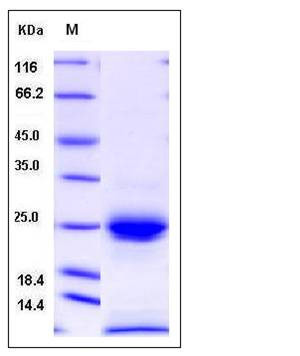Human KLK6 / Kallikrein 6 / Neurosin Protein (His Tag)
Bssp,hK6,Klk7,PRSS18,PRSS9,SP59
- 100ug (NPP4042) Please inquiry
| Catalog Number | P12142-H08H |
|---|---|
| Organism Species | Human |
| Host | Human Cells |
| Synonyms | Bssp,hK6,Klk7,PRSS18,PRSS9,SP59 |
| Molecular Weight | The secreted recombinant human KLK6 (pro form) consists of 239 amino acids and has a predicted molecular mass of 26.6 kDa. The apparent molecular mass of rhKLK6 is approximately 10&25 kDa in SDS-PAGE under reducing conditions due to autolysis. |
| predicted N | Glu 17 |
| SDS-PAGE |  |
| Purity | > 95 % as determined by SDS-PAGE |
| Protein Construction | A DNA sequence encoding the human KLK6 isoform 1 (Q92876-1) (Met 1-Lys 244), was fused with a polyhistidine tag at the C-terminus. |
| Bio-activity | Measured by its ability to cleave the fluorogenic peptide substrate Boc-QARAMC, R&D Systems, Catalog # ES014. The specific activity is > 250 pmols/min/μg. (Activation description: The proenzyme needs to be activated by Lysyl-Endopeptidase for an activated form) |
| Research Area | Immunology |Inflammation / Inflammatory Mediator |Complement and Coagulation |Plasmin/Plasminogen and Kallikrein/Kinin Systems |
| Formulation | Lyophilized from sterile PBS, pH 7.4 1. Normally 5 % - 8 % trehalose, mannitol and 0.01% Tween80 are added as protectants before lyophilization. Specific concentrations are included in the hardcopy of COA. |
| Background | KLK6 (kallikrein-related peptidase 6), also known as Klk7, belongs to the peptidase S1 family, Kallikrein subfamily. Kallikreins are a subgroup of serine proteases having diverse physiological functions. Growing evidence suggests that many kallikreins are implicated in carcinogenesis and some have potential as novel cancer and other disease biomarkers. KLK6 is a serine protease which exhibits a preference for Arg over Lys in the substrate P1 position and for Ser or Pro in the P2 position. Klk7 shows activity against amyloid precursor protein, myelin basic protein, gelatin, casein and extracellular matrix proteins such as fibronectin, laminin, vitronectin and collagen. KLK6 degrades alpha-synuclein and prevents its polymerization, indicating that KLK6 may be involved in the pathogenesis of Parkinson disease and other synucleinopathies. Klk7 may be involved in regulation of axon outgrowth following spinal cord injury. Tumor cells treated with a neutralizing KLK6 antibody migrate less than control cells, suggesting a role in invasion and metastasis. |
| Reference |
